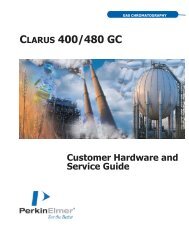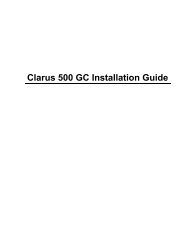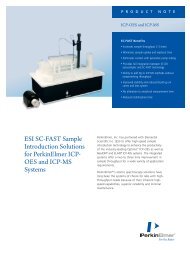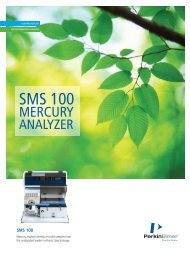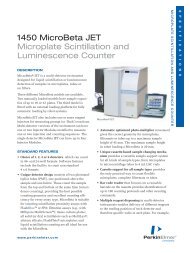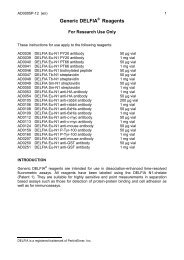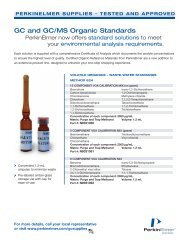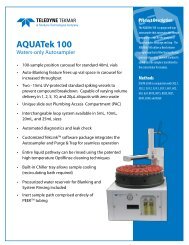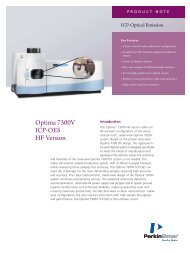HT Protein Charge Variant Kit User Guide - PerkinElmer
HT Protein Charge Variant Kit User Guide - PerkinElmer
HT Protein Charge Variant Kit User Guide - PerkinElmer
You also want an ePaper? Increase the reach of your titles
YUMPU automatically turns print PDFs into web optimized ePapers that Google loves.
<strong>HT</strong> <strong>Protein</strong> <strong>Charge</strong> <strong>Variant</strong> <strong>Kit</strong> <strong>User</strong> <strong>Guide</strong><br />
Optimization of Running Buffer pH<br />
As noted in the Chip Preparation section, the pH of the Running Buffer has a strong effect on the resolution of<br />
charge variants. Typically, as the pH increases, the resolution improves. However, this improvement comes at<br />
the cost of slower migration. The optimum pH for a particular sample balances these two factors. To find this<br />
optimum, we recommend the following procedure:<br />
Initial Test<br />
0) Run samples using the recommendations of Table 2 (see Running the Assay section).<br />
a. If the pIs of samples fall in multiple pI ranges in Table 2, use lowest pH and longest assay type.<br />
pH Optimization<br />
1) Rinse and aspirate each active well of chip (see Chip Preparation section).<br />
2) Prepare Running Buffer at 0.2 or 0.3 units higher than pH used previously; add to wells of chip and to a<br />
new Buffer Tube.<br />
3) Run samples using Running Buffer at higher pH.<br />
a. The samples from step 0 may be re-used throughout the optimization.<br />
b. If the profile of the sample was near the end of the separation time in the previous run, use a<br />
longer assay type.<br />
4) Visually compare the profiles from the run at the higher pH to those from the run at the previous pH to<br />
determine whether the resolution has increased.<br />
a. Indications of increased resolution:<br />
i. Separation between peaks has increased.<br />
ii. Number of peaks has increased.<br />
5) Repeat steps 1 - 4 until the resolution no longer improves. Use the final pH in subsequent runs of<br />
sample.<br />
Additionally, it is possible to determine the<br />
optimal pH by examining the reproducibility of<br />
the % Relative Amounts of the variants, as a<br />
function of pH. Higher pH should provide a<br />
higher reproducibility, as the resolution<br />
increases. For this method of optimization,<br />
we recommend labeling and running multiple<br />
samples of the same mAb (at least three), to<br />
increase the statistical significance of results.<br />
Figure 5 shows the change in the profile of a<br />
mAb when run at various pH. As the pH of<br />
the Running Buffer increases, both the<br />
resolution and the migration time of the<br />
variants increase. Note also, that the peak<br />
height decreases and that the peak width<br />
increases. Finally, the separation between<br />
the free dye peak and the mAb profile<br />
increases at higher pH, so samples with high<br />
pI that may co-elute with the free dye peak at<br />
low pH can be moved away by using a higher<br />
pH.<br />
Figure 5. <strong>Charge</strong> variant profiles of a mAb sample (pI ~8.8) at<br />
various pH.<br />
_________________________________________________________________________________________<br />
Caliper - a <strong>PerkinElmer</strong> Company Page 10 of 18 PN: CLS135474 Rev. 02<br />
68 Elm Street<br />
Hopkinton, MA 01748-1668<br />
1-877-LABCHIP (1-877-522-2447)



